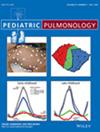预测严重学龄前喘息患者的病情恶化。
IF 2.7
3区 医学
Q1 PEDIATRICS
引用次数: 0
摘要
现在,简单的临床指标、复杂的综合表型/终末分型和远程家庭监测使我们能够从人群或个体层面评估学龄前喘息的风险。在此,我们将讨论临床指标的作用,这些指标涉及子宫内烟雾暴露、病毒-免疫-过敏相互作用的病理生理学以及气道上皮、间质和平滑肌细胞的变化等潜在问题。这一年龄组最重要的未满足需求仍然是疾病改变干预措施。本文章由计算机程序翻译,如有差异,请以英文原文为准。
Predicting exacerbations in severe preschool wheezers.
Simple clinical indices, complex composite phenotyping/endotyping and telehome monitoring now allow us to evaluate the risk of preschool wheezing on a population or individual level. We herein discuss the usefulness of clinical markers which involve underlying issues such as in utero smoke exposure, the pathophysiology of viral-immunological-allergic interactions, and changes in airway epithelium, mesenchyme and smooth muscle cells. The most important unmet need in this age group remains disease-modifying interventions.
求助全文
通过发布文献求助,成功后即可免费获取论文全文。
去求助
来源期刊

Pediatric Pulmonology
医学-呼吸系统
CiteScore
6.00
自引率
12.90%
发文量
468
审稿时长
3-8 weeks
期刊介绍:
Pediatric Pulmonology (PPUL) is the foremost global journal studying the respiratory system in disease and in health as it develops from intrauterine life though adolescence to adulthood. Combining explicit and informative analysis of clinical as well as basic scientific research, PPUL provides a look at the many facets of respiratory system disorders in infants and children, ranging from pathological anatomy, developmental issues, and pathophysiology to infectious disease, asthma, cystic fibrosis, and airborne toxins. Focused attention is given to the reporting of diagnostic and therapeutic methods for neonates, preschool children, and adolescents, the enduring effects of childhood respiratory diseases, and newly described infectious diseases.
PPUL concentrates on subject matters of crucial interest to specialists preparing for the Pediatric Subspecialty Examinations in the United States and other countries. With its attentive coverage and extensive clinical data, this journal is a principle source for pediatricians in practice and in training and a must have for all pediatric pulmonologists.
 求助内容:
求助内容: 应助结果提醒方式:
应助结果提醒方式:


